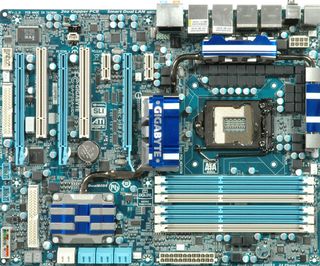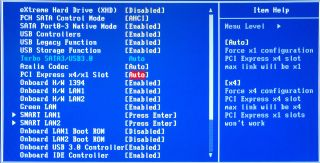USB 3.0, SATA 6Gb/s, Motherboards, And Overcoming Bottlenecks
Soon, 4.8 Gb/s USB 3.0 and 6 Gb/s SATA will be hitting the mainstream. But be careful when you buy your next mainstream motherboard; some don't handle these technologies very well. We compare three implementations and recommend best practice solutions.
Gigabyte P55A-UD6 (Graphics Versus Connectivity)

The P55A-UD6 is a well-equipped LGA 1156 motherboard, and one of our recommendations in last year’s Holiday Buyer’s Guide. It also made an appearance in our December 2009 enthusiast P55 motheboard review.
The board's feature list starts with a 24-phase dynamic voltage regulator design offering significant power supply capabilities, and continues with a long list of connectivity options. These include CrossFire support, three x16 PCI Express slots, and JMicron JMB362, ITE 8213, and Marvell 88SE9128 controllers for eSATA, UltraATA/133 and SATA 6Gb/s, respectively. The benefit of three different chips is that each can be linked to a separate PCI Express 1.1 lane, resulting in better distributed bandwidth. Not least of all, there's an NEC controller for USB 3.0.
This and the SATA 3.0 controller are routed through a PCI Express pathway selector switch, allowing the two components to draw connectivity from the processor's second-gen links or the PCH's second-gen links (handicapped by Intel to first-gen throughput). You're either limiting graphics performance/connectivity or SATA/USB throughput. That's a tough choice to make either way.

The motherboard can control PCIe lane assignment, or you can manually define whether USB 3.0 or SATA 3.0 should utilize maximum bandwidth. If you take the manual route, you won't be able to run dual graphics cards. Alternatively, if you install CrossFire, you'll face a serious performance impact on the SATA 3.0 chip (as we'll see shortly). This is not inherently Gigabyte’s fault. It's simply a matter of insufficient total bandwidth to accommodate the new high-speed interfaces and dual graphics from Intel's mainstream chipset.

Stay on the Cutting Edge
Join the experts who read Tom's Hardware for the inside track on enthusiast PC tech news — and have for over 25 years. We'll send breaking news and in-depth reviews of CPUs, GPUs, AI, maker hardware and more straight to your inbox.
Current page: Gigabyte P55A-UD6 (Graphics Versus Connectivity)
Prev Page Bottlenecks And Solutions For USB 3.0 And SATA 6Gb/s Next Page Gigabyte P55A-UD7 (Maximum Connectivity And PCIe Switching)